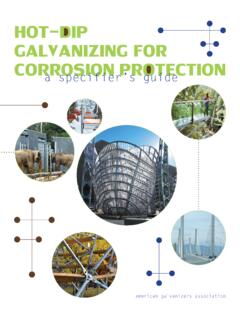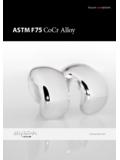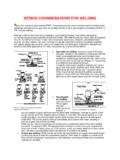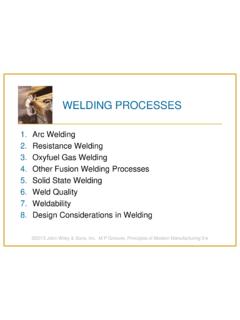Transcription of ELEMENTS, COMPOUNDS & MIXTURES
1 Name: Class: . ELEMENTS, COMPOUNDS & MIXTURES . Page 1 of 3. Domain: relates properties of elements, COMPOUNDS and MIXTURES to scientific models, theories and laws What is an Element? An element is a simple pure substance which cannot be made simpler using chemical means. A pure substance is a form of matter that has the same composition throughout. Elements are the building blocks of matter. Everything around us is made up of an element or elements. All the known elements are listed in a special table called the Periodic Table. There are 115 known elements. 92 of these elements occur naturally. Of the 92 naturally occurring elements there are: * 11 gases (hydrogen, oxygen, nitrogen, fluorine, chlorine, helium, neon, argon, krypton, xenon.)
2 * 2 liquids (mercury and bromine);. * 79 solids (mostly metals). Atomic Note: the elements are in these states at room temperature (25oC). 11 number Na Each element in the table is denoted by a symbol. The symbol for sodium is shown. Symbol You will need to learn some of the symbols given on the Periodic Table. Sodium Name An element is made up atoms joined together. The atoms are all the same for a particular element. For example, copper is made up of copper atoms, iron is made up of iron atoms etc. Some important facts about elements include: An element is made up of atoms which are all the same: M The most common element on Earth is oxygen (about 50%).
3 M The least common naturally occurring element is Astatine;. M The most recently discovered element was Ununoctium - it was produced artificially. M Scientists believe that all matter in the universe is composed of the same elements that are present on Earth. What is a Compound? A compound is a pure substance that consists of atoms of two or more elements joined together. COMPOUNDS are formed when atoms of different elements react together. COMPOUNDS can be decomposed into elements using chemical means. Most pure substances are COMPOUNDS . COMPOUNDS have a chemical formula. The chemical formula is made up from the symbols of the elements in the compound. It also indicates the number of atoms of each element in the compound.
4 An example of a very important compound is water. Water is made up of two elements- hydrogen and oxygen. The chemical formula for water is shown. Other important COMPOUNDS are: Compound: Formula: The H2O. symbol sodium chloride (common salt used NaCl for for cooking) The symbol for oxygen. hydrogen. (H) (O). carbon dioxide (a gas found in the CO2. atmosphere). The formula indicates there are two (2) hydrogen sucrose (common sugar) C12H22O11 atoms for every one (1) oxygen atom. The elements which react together to form a compound have different properties to the compound formed. For example, sodium (a very reactive metal) can combine chemically with chlorine (a poisonous gas) to form sodium chloride, a chemically harmless white powder which we call salt.
5 ELEMENTS, COMPOUNDS & MIXTURES . Page 2 of 3. What is a Mixture? A mixture is made up of two or more pure substances. These substances are not joined chemically and can be separated without using chemical means. MIXTURES are said to be impure. An example of a mixture is air. It is made up of nitrogen, oxygen and oth- er gases. These gases are not chemi- cally combined. MIXTURES can be separated into the substances which make up the mix- ture. Methods of separating MIXTURES include filtration, distillation and chromatography. What is a Molecule? Atoms can be bound together as a molecule. Elements can be in the form of molecules. For example, oxygen consists of molecules which are two oxygen atoms bound together (O 2).
6 COMPOUNDS can also be in the form of molecules. An example of a molecule which is a compound is carbon dioxide (CO 2). Water is also a compound which consists of molecules. COMPOUNDS can also have a crystalline structure. For example, sodium chloride (table salt) is crystalline when not dissolved in water. Questions: 1. What is an element? 2. What is a pure substance? 3. Complete the sentence: elements are the building blocks of _____ . 4. Complete the sentence: the known elements are listed in the _____ _____ . 5. How many known elements are there? 6. What are the elements made up of? 7. What is the most common element on Earth? 8. What is a compound? 9. How are COMPOUNDS formed?
7 10. Complete the sentence: most pure substances are _____ . 11. What does a chemical formula show? 12. (a) What is the chemical formula for water? (b) What elements are in water? (c) What is the ratio of hydrogen atoms to oxygen atoms in water? matter 13. What is the formula for: (a) sodium chloride; (b) carbon dioxide; (c) sucrose? 14. Complete the sentence: sodium chloride is common _____ . 15. In sucrose, what is the ratio of atoms for each element? 16. What is a mixture made up of? pure impure 17. Complete the sentence: MIXTURES are not joined _____ and can be two or more _____ . 18. (a) What is a molecule? cannot be made simpler by chem- elements C. (b) Name an element which exists as ical means combined a molecule.
8 (b) Name a compound which exists as A B. Name: Class: . ELEMENTS, COMPOUNDS & MIXTURES . Page 3 of 3. Domain: describes observed properties of substances using scientific models and theories 20. On your Periodic Table: * colour in the elements which are gases; Solid Liquid Gas * colour in the elements which are liquids. Include a suitable key 21. Complete the following table by finding the information on your Periodic Table: Element Atomic Symbol State Element Atomic Symbol State Number (s,l or g) Number (s,l or g). Hydrogen 1 Argon 18. Helium 2 Potassium 19. Lithium 3 Calcium 20. Beryllium 4 Iron 26. Boron 5 Copper 29. Carbon 6 Zinc 30. Nitrogen 7 Bromine 35.
9 Oxygen 8 Silver 47. Fluorine 9 Tin 50. Neon 10 Iodine 53. Sodium 11 Barium 56. Magnesium 12 Platinum 78. Aluminium 13 Gold 79. Silicon 14 Mercury 80. Phosphorus 15 Lead 82. Sulfur 16 Uranium 92. Chlorine 17. Name: Class: . ELEMENTS, COMPOUNDS & MIXTURES . Page 3 of 3. Domain: describes observed properties of substances using scientific models and theories 20. On your Periodic Table: * colour in the elements which are gases; Solid Liquid Gas * colour in the elements which are liquids. Include a suitable key 21. Complete the following table by finding the information on your Periodic Table: Element Atomic Symbol State Element Atomic Symbol State Number (s,l or g) Number (s,l or g).
10 Hydrogen 1 H g Argon 18 Ar g Helium 2 He g Potassium 19 K s Lithium 3 Li s Calcium 20 Ca s Beryllium 4 Be s Iron 26 Fe s Boron 5 B s Copper 29 Cu s Carbon 6 C s Zinc 30 Zn s Nitrogen 7 N g Bromine 35 Br l Oxygen 8 O g Silver 47 Ag s Fluorine 9 F g Tin 50 Sn s Neon 10 Ne g Iodine 53 I s Sodium 11 Na s Barium 56 Ba s Magnesium 12 Mg s Platinum 78 Pt s Aluminium 13 Al s Gold 79 Au s Silicon 14 Si s Mercury 80 Hg l Phosphorus 15 P s Lead 82 Pb s Sulfur 16 S s Uranium 92 U s Chlorine 17 Cl g Name: Class: . There are 92 naturally occurring elements 3 Atomic number (Z) 1 At room temperature and pressure: 2. Li H 2 are liquids (Hg and Br) He Symbol 11 are gases (H,N,O,F,Cl,He,Ne,Ar,Kr,Xe,Rn) Lithium Relative atomic mass Hydrogen the rest are solids Helium Name of element 3 4 5 6 7 8 9 10.






